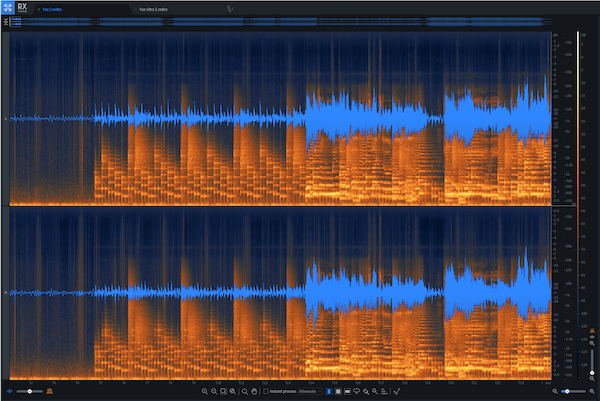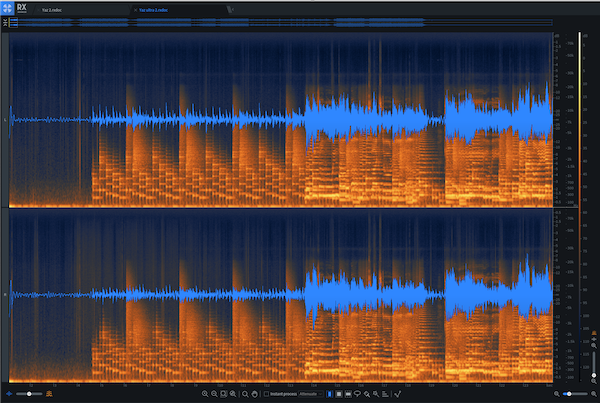This is very helpful, thanks a lot!
On another subject. I‘ve come across this video:The guy claims, that he killed a record as a result of 12 cleaning 5 minute cycles in Humminguru machine. That got me very worried, as I’ve just cleaned several very expensive records and probably did between 8 and 10 5 minutes cycles in Kirmuss. I wanted to be very thoroughThe tank in Kirmuss is much larger compared to the one in Humminguru, but still, do you think that 8 or more cycles in Kirmuss can actually damage a record?
Thanks in advance,
Aziz
Aziz,
@tima has good points but let me provide some other info.
The HG uses a very small tank (~400-ml) and the two transducers are mounted one on each side of the record and very close to the record. The Kirmuss is just an iSonic UT tank P4875-NH+MVR5 | iSonic® Ultrasonic Vinyl Record Cleaner for 5-LPs, 2Ga – iSonic Inc. with three bottom firing ~60W transducers with a custom slot-spinner. iSonic has little technical details other than the those with the heater have a total power draw of 380W (probably 200-220W for the heater and ~160-180W for the transducers), and some of these transducer ratings are shall we say optimistic. These two machines are very different.
I believe that video says he cleaned the record in the HG something like two-dozen sequential times. He says the record was damaged. I do not recall if he said exactly what record was damaged (it can make a difference as I will explain). If the record is actually damaged, there may be some visible damage to the very smooth surface of the run-out groove area. That smooth area has the same 'smoothness" (technically the surface roughness) as the groove. If you have ever used a FIX WARPED RECORDS | Vinyl Flat or similar and overheated the record, the smooth surface of the run-out groove area takes on an orange peel type finish and the record sounds how it looks.
So, we have this one data point using the (HG) equipment completely contrary to how it's supposed to be used and not IAW with manufacturer's procedures and the HG has a very good operators manual - HumminGuru_HG01_Owner_s_Manual_English_Version.pdf (shopify.com). And I recently wrote at the Steve Hoffman Forum:
So, did you damage your record by using applying 8-10 five-minute cleaning cycles with a 30-min break in-between. Very unlikely. The Kirmuss iSonic unit is not that powerful a unit and the records are not that close to the transducers.Let me pose a question, is doing many sequential cleanings in a very short period of time the same as doing the same number cleanings in smaller groups spread across weeks, months or years? How a material reacts to many repeated impacts/shocks (from cavitation implosion energy) in short period of time is different than when a small of group of repeated impacts/shocks applied over a much wider period. It has to do with the impact/fatigue resistance properties of the material. So, it's premature to extrapolate that what happened in this one 'test' is predictive of the record's total allowable number of impacts/shocks (from cavitation implosion energy) that may be accumulated over its life such as cleaning the record 3 to 4-times over many months or years. Based on the experience of users who have performed repeated cleaning over time with 37-kHz UT machines (Elmasonic P-series dual frequency 37-kHz and 80-kHz) and 40-kHz UT machines is that no damage is experienced. Note that many uses have modified their cleaning processes which cause them to reclean their record and have accumulated ultrasonic exposure to the record far exceeding 60-min.
Additionally, note that there are some flies in the ointment to say and that is the variability in the record material that could affect its impact/fatigue resistance properties, and the initial condition of the record. If the particular record surface is deficient in a manner that alters its impact/fatigue resistance properties, then the results of doing many sequential cleanings in a very short period of time can vary. In which case, there can be no conclusion drawn as whether the HG test results will occur with every record, nor that the DG test will occur every record. Note that two of the same records, can have different material properties; it's the nature of the record composition and the additives added. Variations in the proportions and in the pressing time, temperature and pressure can all lead to variations in the record's final properties.
Something is wrong, but exactly what is wrong hard to pin-down because no one knows what is in his secret sauce. If you watch this video starting at time 21:00, Axpona 2023 Video Coverage Begins Here | Tracking Angle, the records that Fremer provided are old RCA label records. The RCA record formula starting from the early 1960's used a cationic surfactant to coat the vinyl pellets. But in this case, it provides an inherent reservoir and is leached to the surface in a controlled fashion, ref: article Anti-Static Phonograph Records, G. P. Humfeld, begins page 18 1960-10-11.pdf (worldradiohistory.com). Anionic and cationic surfactants are generally incompatible if mixed at the right proportions, a white tacky residue can form.I always get the white foam and keep repeating the cycles hoping it will diminish after the next one, but it does not change.
In his patent application (which to my knowledge has not been awarded) Universal Ultrasonic Record Cleaning Device And System KIRMUSS; CHARLES BRUNO [KIRMUSS; CHARLES BRUNO] (uspto.report) he describes "...applying, via an applicator, an ionizing surfactant to the recording media,...". So, is the Kirmuss cleaning spray an anionic surfactant reacting with the RCA cationic anti-static vinyl? Or is it a positive charge cationic surfactant that just so happens to react with the RCA record formula? By his writing, the spray appears to contain a positive charge cationic surfactant. Cationic surfactants are very hygroscopic (that is what makes them useful as anti-static agents). But after all is said and done, using something that may be reacting with the surface or intentionally leaves a film on the surface somewhat contradicts the whole cleaning process noting that cationic surfactants are not very good cleaners and want to bond to the record surface and are then not easily removed by rinsing.
Not to belabor this point, but rigorous art conservationists are not going to risk valuable art items using mystery cleaners. And I take the same approach. I am not going to use or recommend any cleaning agent that I do not know the ingredients and even then, I will do my own analysis (review of all available test literature) to determine if there is any material compatibility risk which is why the book has a separate chapter on nothing more than Material Compatibility. This follows one of the three tenants of cleaning - Do No Harm.
Anticipating your next question, are you harming a record by repeatedly applying his 'process' trying to get the record to stop reacting to his cleaner, I wish I could give a firm answer. Have you rinsed your brush with distilled/demineralized water (DIW) and verified that if using only the brush with DIW no white foam appears? You need to make sure you can isolate the problem to casual factor. If you isolate to his spray, does this happen with all records or some records? If it occurs with all records, it could be a problem with that batch of cleaner noting that to get to you it has travel quite a distance. If it occurs with only some records - what's the vintage and history of ownership. If the record is contaminated with surfactant residue from years of say DISCWASHER™ usage 1498409355778615785-03951841 (storage.googleapis.com) using his spray cleaner is probably not the best way to remove that residue. You need something with a lot more cleaning ability which is why I address in the UT pre-clean step using a nonionic surfactant at full strength for wetting and detergency plus 2.5% IPA. However, for really 'gross' records, this is when manual-sink pre-clean with more aggressive (but neutral pH) detergents like the Alconox Liquinox I discuss in the book come in.
As I have said far too many times, in this area, the Devil is in the Details. And as a caution, recall what Inventor Nikola Tesla said of the Edisonian trial & error method (Edisonian approach - Wikipedia) "[Edison's] method was inefficient in the extreme, for an immense ground had to be covered to get anything at all unless blind chance intervened and, at first, I was almost a sorry witness of his doings, knowing that just a little theory and calculation would have saved him 90 percent of the labour"
Take care & stay well,
Neil






